ORGANIC CHEMISTRY –I
Anuncio
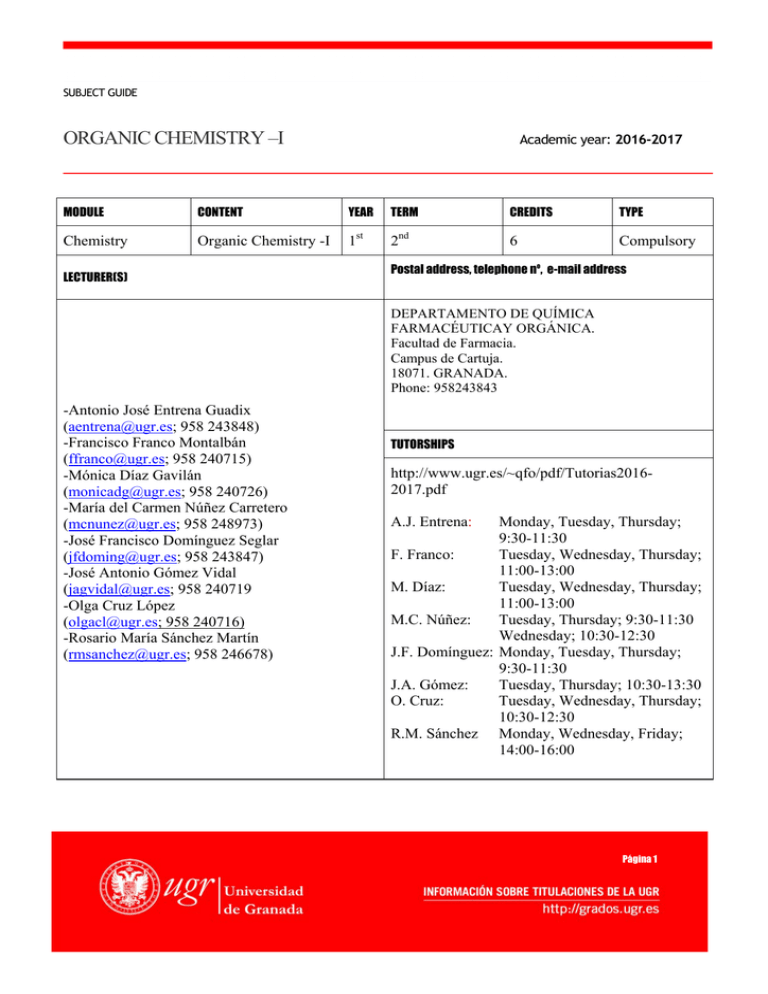
SUBJECT GUIDE ORGANIC CHEMISTRY –I Academic year: 2016-2017 MODULE CONTENT YEAR TERM CREDITS TYPE Chemistry Organic Chemistry -I 1st 2nd 6 Compulsory LECTURER(S) Postal address, telephone no, e-mail address DEPARTAMENTO DE QUÍMICA FARMACÉUTICAY ORGÁNICA. Facultad de Farmacia. Campus de Cartuja. 18071. GRANADA. Phone: 958243843 -Antonio José Entrena Guadix (aentrena@ugr.es; 958 243848) -Francisco Franco Montalbán (ffranco@ugr.es; 958 240715) -Mónica Díaz Gavilán (monicadg@ugr.es; 958 240726) -María del Carmen Núñez Carretero (mcnunez@ugr.es; 958 248973) -José Francisco Domínguez Seglar (jfdoming@ugr.es; 958 243847) -José Antonio Gómez Vidal (jagvidal@ugr.es; 958 240719 -Olga Cruz López (olgacl@ugr.es; 958 240716) -Rosario María Sánchez Martín (rmsanchez@ugr.es; 958 246678) TUTORSHIPS http://www.ugr.es/~qfo/pdf/Tutorias20162017.pdf A.J. Entrena: Monday, Tuesday, Thursday; 9:30-11:30 F. Franco: Tuesday, Wednesday, Thursday; 11:00-13:00 M. Díaz: Tuesday, Wednesday, Thursday; 11:00-13:00 M.C. Núñez: Tuesday, Thursday; 9:30-11:30 Wednesday; 10:30-12:30 J.F. Domínguez: Monday, Tuesday, Thursday; 9:30-11:30 J.A. Gómez: Tuesday, Thursday; 10:30-13:30 O. Cruz: Tuesday, Wednesday, Thursday; 10:30-12:30 R.M. Sánchez Monday, Wednesday, Friday; 14:00-16:00 Página 1 DEGREE WITHIN WHICH THE SUBJECT IS TAUGHT Pharmacy PREREQUISITES and/or RECOMMENDATIONS (if necessary) The student should have taken the previous Chemistry courses BRIEF ACCOUNT OF THE SUBJECT PROGRAMME (ACCORDING TO THE DEGREE ¿??) Structure and stereochemistry of the organic compounds. Common analytical technicques used for the elucidation of the organic compounds. Alkenes, alkenes and alkynes, reactivity and synthetic methods.. GENERAL AND PARTICULAR ABILITIES Generic Abilities: CG1 Specific Abilities: CEM1.3, CEM1.4, CEM1.5, CEM1.8 y CEM1.11 OBJECTIVES (EXPRESSED IN TERMS OF EXPECTED RESULTS OF THE TEACHING PROGRAMME) The student should be able to: 1. Understand and apply the knowledge comply in the subject. 2. Use the basic organic chemistry laboratory operations in order to synthesize, purify and structurally characterize simple organic molecules. DETAILED SUBJECT SYLLABUS TEORIC CHAPTERS: Chapter 1. MOLECULAR CONSTITUTION Main characteristic of carbon bonds. Multiple bond systems: aromaticity and conjugation. Chapter 2. MOLECULAR CONFORMATION Conformational Analysis. Cyclic and acyclic organic carbon chains. Chapter 3. MOLECULAR CONFIGURATION: STEREOCHEMISTRY Stereoisomerism: concept and classification of the organic compounds. Chirality. Optical activity. Absolute and relative configuration: The Cahn, Ingold and Prelog Rules. Molecules with several chiral centers. Optical isomers of cyclic compounds. Stereochemistry of carbohydrates. Stereochemistry of compounds without chiral centers. The importance of chirality in pharmacy. Chapter 4. STRUCTURE ELUCIDATION OF ORGANIC COMPOUNDS BY PHYSICAL METHODS Infrared spectroscopy. Mass Spectrometry. NMR spectroscopy: Theory and applications of the chemical shift. Coupling constants and their utility in the elucidation of the organic structure. Modern NMR techniques. Chapter 5. SATURATED HIDROCARBONS: ALKANES Classification of hydrocarbons: Alkanes: physical properties and natural sources. Synthesis and reactivity of alkanes. Halogenation of alkanes: radical substitution reaction on saturated carbons. Chapter 6. UNSATURATED HIDROCARBONS: ALKENES Página 2 Structure and physical properties. Synthesis of alkenes: Elimination reactions. Reactivity of alkenes: Addition reactions on double bonds. Oxidation reactions. Allylic substitutions. Conjugates dienes. Polymerization reactions. Chapter 7. UNSATURATED HIDROCARBONS: ALKYNES Structure and physical properties. Acidity of acetylide. Synthesis and reactivity of alkynes. LABORATORY: 1. Cannizzaro reaction on benzaldehyde. 2. Synthesis of acetanilide. 3. Synthesis of dibenzylideneacetone. 4. Synthesis of ethyl acetate. 5. Liquid-liquid extraction for the separation of organic mixtures. READING BASIC BIBLIOGRAPHY: - C. VOLLHARDT, N.E. SCHORE. Química Orgánica: Estructura y Función. Ed. Omega. 3ª Edición, 2008. - DAVID KLEIN. Química Orgánica. Ed. Médica Panamericana, 1ª Ed. 2012. - F.A. CAREY. Química Orgánica. Ed. McGraw-Hill. 6ª Edición, 2006. - L.G. WADE, Jr. Química Orgánica. Ed. Pearson, 7ª Edición, 2012. - T. W. GRAHAM SOLOMONS. Organic Chemistry. Ed. Wiley. 10ª Edición, 2010. - J. CLAYDEN, N. GREEVES, S. WARREN, P. WOTHERS. Organic Chemistry. Oxford University Press, 2001. COMPLEMENTARY BIBLIOGRAPHY: - J. MARCH. Advanced Organic Chemistry: Reactions, Mechanisms, and Structure, 7ª edition Ed. Wiley, 2013. - F. A. Carey; R. J. Sundberg. Advanced Organic Chemistry, Part A: Structure and Mechanisms Advanced Organic Chemistry: Part B: Reaction and Synthesis 5 Edition, Ed Springer, 2007 PROBLEMS - F. GARCIA CALVO-FLORES, J. A. DOBADO, Problemas resueltos de Química Orgánica, Ed. Thomson, 1ªEd, 2007. - H. MEISLICH. Química Orgánica, (3ª Ed.). Ed. Mc Graw Hill-Interamericana, 2001. - E. QUIÑOÁ y R. RIGUERA. Cuestiones y ejercicios de Química Orgánica. Una guía de autoevaluación (2ª Ed.) Ed. Mc Graw Hill 2004. NOMENCLATURE - W.R. PETERSON. Formulación y Nomenclatura. Química Orgánica. EUNIBAR. - E. QUINOÁ, R. RIGUERA. Nomenclatura y representación de los compuestos orgánicos. Ed. Mc Graw-Hill, 2005. EVALUATION (EVALUATION CRITERIA) The evaluation will be based on exams and personal work made by the student along the semester. During the evaluation process the student must show a minimum and uniform knowledge of all the questions evaluated. Exceptionally, the teacher could ask for an additional and supplementary oral exam to justify the student knowledge. The practical lessons are mandatory to pass the subject. The student MUST ATTEND ALL the practical lessons and pass the corresponding exam. Calls to the practical lessons must be attended by all substitute students at the date and time specified in the call. Students with improperly justified absence during the call will not be call again. Página 3 None of the passed exams will be saved for following academic years or for the September exams. Approved practices are not saved for the next academic year, neither for the special examination in September. Link to Criteria for Students Evaluation (UGR): http://farmacia.ugr.es/noticias/docu/NormEVALUACINYCALIFICACIN.pdf EVALUATION LEARNING OUTCOMES SE.1, SE.2, SE.3 and SE.4 Theory classes SE.7, SE.8, SE.9, SE.10, Laboratory classes, elaboration and exposition SE.5, SE.11, SE.12 and SE.15 of homework SE.15 Class attendance % MARKING 85-100 0-10 0-5 The values in % of the markings will be set at the beginning of the course by the instructor/instructors of the subject. RECOMMENDED INTERNET LINKS Chemistry Dictionary ChemistryGuide IUPAC Nomenclature of Organic Chemisty Organic Syntheses Organic-Chemistry Departamento de Química Farmacéutica y Orgánica (UGR) Página 4
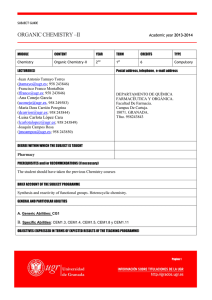
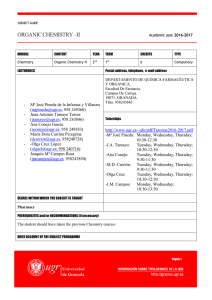
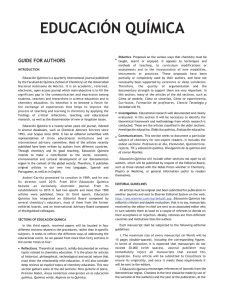
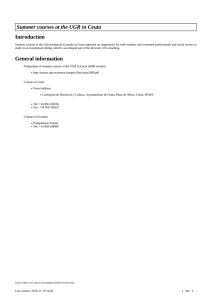
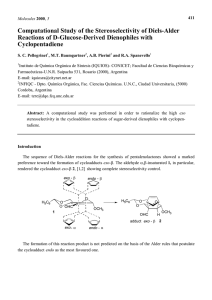
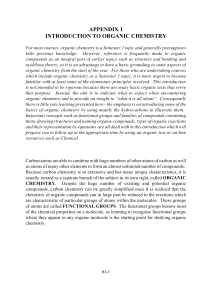
![Poster_Rotterdam_1 [Modo de compatibilidad]](http://s2.studylib.es/store/data/005946173_1-c064b2a56cd27a696e23b166c7651db0-300x300.png)